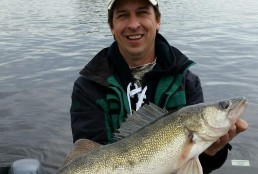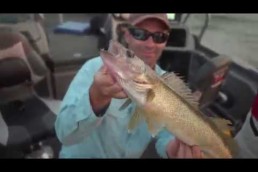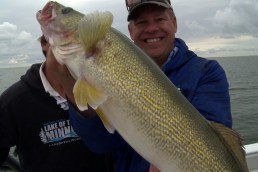Inshore Walleyes on Big Traverse Bay
SHARE THIS POST
It’s been a busy 60 days for the adult walleyes of Minnesota’s Lake of the Woods. Roughly, the past 2,000 hours in their lifespan have been spent on epic journeys.
Each spring, instinct drives them back to the shallow gravel areas that started the chain of which they are a part of today. For the largest and oldest fish of the system, their part of the process started sometime in the 1990s. A walleyes first few seasons are spent focused on growing and avoiding the fate of most fish—prey of bigger fish. Safety in numbers is about the only card they have to play in the early stages of life. Other factors that determine their future are forage, water temperature, sunlight, wind and the populations of other types of prey available to the lake’s predators, which are beyond their control. The walleyes that manage to survive those first few years join the spawning cycle, continuing what was started long ago.
Spawn run of 2016 looking good
The early ice-out on Lake of the Woods was disappointing to many who enjoy their yearly March ice fishing adventure. The angler’s loss is the walleyes gain as the lake absorbed the sun’s warmth. Good current flow on the Rainy River, combined with a minor runoff, set in play a strong spring-river bite. Another big plus was that the largest spring precipitation was a measureable snow event, slowing the water as it entered the Rainy River basin. Fast runoff creates dirty water in the Rainy River, and is a “switch” that can turn off a great bite in short order. April 14 was the last day of the spring walleye season, and the upper sections of the Rainy were producing big numbers of 3- to 7-pound pre-spawn females all released, per MNDNR regulations. The female walleyes’ stomachs were still firm with spawn at this point and the males had not started milking. Best guess is the river spawning process would have been underway by the last week of April earlier this season.
Meanwhile, some 40 miles downriver at the close of the spring season, anglers we able to access LOW, via the lighthouse gap. The moving ice pack remaining on the lake meant that you needed to be aware of wind conditions—south being the wind of choice for this adventure. On the right April days, boats were able to reach in 17 to 18 feet of water alongside the ice outside of Pine Island.
The earliest adventurers found bigger females willing to bite, but by mid-April, 14- to 20-inchers in volume were the dominant size caught on accessible parts of the lake with a few larger mixed in. The end of April was the end of the ice. May brought warmer south winds to set the spawn in motion on the shorelines.
At about the same time, the upriver spawning walleyes began their trip back home to the lake. Riding the current back, they take advantage of what the river has to offer, stopping and feeding along the way. By the end of May most have made it back, joining lake walleyes recovered from the spawning process.
Are you enjoying this post?
You can be among the first to get the latest info on where to go, what to use and how to use it!
June has shallow, hungry walleyes
Per angling hours here, June is the most popular month of the open-water season on LOW. Locally, they call it shore fishing. Unlike most “other” shore fishing scenarios, here it is done by boat. The advantage anglers have is that the fish are hungry and congregated in shallow water. Shallow water also means close to home and the shore, which is comforting on a lake so large, especially for anglers just getting comfortable on the big water.
The walleyes are focused on the shallow water because the presence of baitfish. These are using the warming shoreline water to feed and perform spawning processes. Generally, 20 feet or shallower is the ticket, putting you within a mile or less from shore in places like, Pine Island, Long Point, Rocky Point and the south shore. The baitfish do seem to like using the sandy shorelines at this time of year, drawing walleyes into 10 feet and less. At times, they seem to be as shallow as one may dare to take their boat, and probably even shallower with the bog-like, stain-colored water over the cover.
Lake of the Woods has separate possession limits for walleyes and saugers, and it is not uncommon to have to venture a little deeper, seeking softer bottoms to finish of the limit of the latter. The area between the Lighthouse Gap, where the Rainy River enters the lake to Rocky Point south and west of Long Point, offers around 30 miles of shoreline to fish. There’s plenty of room to explore if you desire fishing on your own, otherwise large packs of boats are a giveaway to where schools of walleyes are. Walleyes and saugers dominate the fishery, so when you graph fish, it is very likely that what you are seeing is real. In the shallow water, the cone angle of your electronics is small. When you graph a couple you can bet there is more fish.
Traditional tactics
A wide assortment of presentations will produce big numbers. The walleye standards, like a jig and minnow or a live-bait rig with a nightcrawler or leech, are productive. When fish are less concentrated on a particular spot, a 2- to 3-ounce bottom-bouncer and spinner rig teamed with a ‘crawler, leech or minnow, can help you cover water when they are scattered and deeper. In 10 feet or less, try the same rig with a 1/4- ounce sinker, keeping the presentations somewhat farther from the boat. Both drifting and trolling work well when using spinners, allowing you to present a bait to more fish when they seem to be using an area vs. a spot. Color can make a big difference too. On sunny days, look to bright colors, and on cloudy days, use darker colors. I use silver and gold to start.
Lake of the Woods is technically a reservoir, and like walleyes in all reservoirs, they have a sweet tooth for crankbaits. It pretty tough to beat a number 7 Shad Rap when working the shallows; the action mimics what they are looking to feed on. The bait will let you cover the water out to about 15 feet, depending on the type and amount of line you run back. Thin-diameter superline will get your lures a couple feet deeper when long lining vs. mono if you’re new to the presentation. Once you pass the 15-foot mark, leadcore line becomes the popular choice for getting the crankbaits down. At this point, you can also downsize to smaller crankbaits, as the lead line is what achieves the extra lure depth. LOW is a great place to hone your crankbait fishing skills, whether it’s long-lining, leadcore fishing or downrigging—you can also save the downrigger fishing for what’s around the corner in the months to come.
Minnesota’s Lake of the Woods has over 50 resorts, plus hotels with lodging options to fit any budget. Most offer full-service charter fishing with experienced captains that can make a day of catching look pretty easy. It’s a fun and easy way to boat a bunch of fish, and everybody gets to have a good time without trailering a boat. Like any lake you may go to, make sure you research the local lake regulations. For more information and lodging options, go to lakeofthewoodsmn.com.
MWO
SHARE THIS POST
Did you enjoy this post?
You can be among the first to get the latest info on where to go, what to use and how to use it!
Greg Jones
MidWest Outdoors works with more than 200 outdoor experts each year, who contribute articles based on their areas of expertise. MidWest Outdoors magazine offers more fishing and hunting articles than any other publication!



